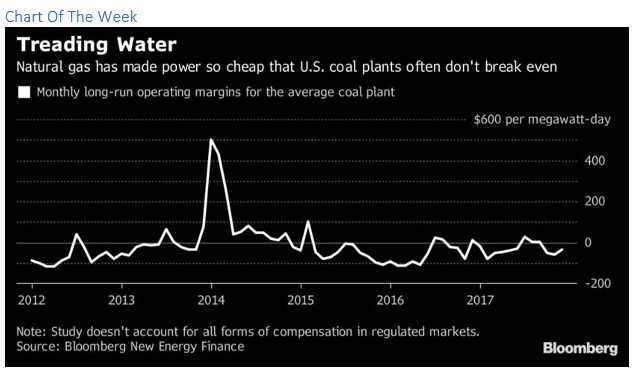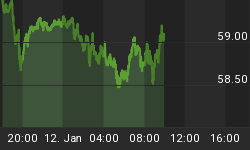Monday, March 26, 2018
Financial markets rebound. Global equities rebounded at the start of trading on Monday, after a steep selloff last week. The Trump administration, even by its standards, left the markets suffering from whiplash after a wild ride of surprise policy announcements. $60 billion in tariffs on Chinese goods combined with the radical shakeup of Trump’s cabinet led to a spike in geopolitical concerns, sparking a slide across financial markets. By Monday, investors seemed to have calmed a bit, and have scooped up discounted assets.

(Click to enlarge)
- Many U.S. coal plants are struggling. In fact, almost half of U.S. coal plants were in the red last year, according to Bloomberg.
- Cheap natural gas is killing coal. Coal only does well during extreme cold weather snaps, such as the polar vortex in 2014.
- Some “out-of-the-money” coal plants remain online because regulators deem them important for grid reliability, but those markets are only in specific regions of the country.
Markets
Trump’s $60 billion in tariffs on Chinese strategic industries. The Trump administration unveiled $60 billion in tariffs on Chinese goods last Thursday, and the levies targeted 10 sectors that are strategically vital for China, laid out in its “Made in China 2025” plan. As the FT reports, these include: advanced IT products; automated machine tools and robotics; aerospace and aeronautical equipment; maritime equipment; modern rail equipment; electric and other “new energy” vehicles; power equipment; agricultural equipment; “new materials”; biopharmaceutical and other advanced medical products. Markets are now waiting on a retaliation from China.
A “more severe” stock market correction ahead. The head of Allianz predicts a “more severe” stock market correction lies ahead in the future. "Equity markets have really been buoyant for a long time now and valuations are extremely high, higher than you can actually justify based on fundamentals," Allianz Chief Executive Oliver Bate told CNBC. "Markets are starting to get jittery and we would expect a more severe correction over the medium to long term," he said. He added that market risk is “severely mispriced.” Related: The SEC’s 5 Warnings About ICOs
The Fed hikes interest rates, but forecast remains the same. The Federal Reserve hiked interest rates by a quarter-point last week, although it still forecasts that the federal funds rate will hit 2.1 percent by the end of 2018, which is unchanged from its December forecast. There had been speculation that the central bank might raise rates four times this year, but the Fed signaled last week that it will stick with three rate increases. However, the Fed said that the federal funds rate would likely rise to 2.9 percent in 2019 and 3.4 percent in 2020, both upward revisions.
Commodities
Two risks threaten commodities. Reuters analyst Clyde Russell argues that there are two trends that could dramatically affect commodities this year, one bullish and one bearish. There is evidence that mining companies might overspend and overpay for assets, injecting too much capital into projects based on overly-optimistic forecasts. That could inflate prices. On the flip side, the brewing U.S.-China trade war could slow economic growth, which could be a significant headwind for commodities.
Gold prices hit 5-week high. Gold prices shot up last week by 3 percent over market uncertainty that led to a flight into safe haven assets. Concerns of a trade war, an actual war (Iran, North Korea) and the declining dollar all worked in the favor of gold. Gold prices rose to a 5-week high. “Gold’s gains feel unexpected, but considering the growing volatility in the equity markets and uncertainty surrounding the Chinese-U.S. tariffs, the implications from a larger trade war are sending safety into precious metals,” said Peter Spina, president and chief executive officer of GoldSeek.com.
China’s control over cobalt grows. Chinese battery maker GEM signed a massive cobalt supply deal with Glencore (LON: GLEN) in mid-March, which would see a third of Glencore’s supply heading to China over the next three years. It is also equivalent to about half of the world’s cobalt production in 2017, and the deal will likely continue to up push prices, which had already been shooting up for the past two years. The deal also raised concerns about the concentration of the cobalt market – reserves are overwhelmingly concentrated in the Democratic Republic of the Congo, and the processing capabilities are largely located in China.
Energy
China launches oil futures contract. Monday marked the first day of trading for China’s new oil futures contract on the Shanghai International Energy Exchange. The September contract is reportedly the most heavily traded thus far, according to S&P Global Platts. S&P said that there were 413 participants at the start of trading, including state-owned oil companies (Unipec, CNOOC, Sinochem, Northern Petroleum), independents and also foreign traders (Trafigura, Glencore and Freepoint). The yuan-denominated contract could rival Brent and WTI for prominence in the global oil trade. It could also bolster the yuan and give China more pricing influence over oil flows.
Oil trading profits decline for Vitol Group. Vitol Group, the world’s largest independent oil trader, reported a 25 percent decline in annual profits for 2017, the result of a deteriorating in the trading environment. The dip in earnings to $1.5 billion, down from $2 billion a year earlier, came as the oil futures curve moved decidedly into a state of backwardation for much of last year, a situation in which front-month oil futures trade at a higher price than contracts dated further out into the future. Such a pricing structure makes it unprofitable to store oil and sell at a later date, a grim situation for oil traders. “It is pretty bloody tough,” Vitol Chairman Ian Taylor said in a Bloomberg interview last week. “And I don’t think anybody is making a lot of money.”
Spike in geopolitical uncertainty. President Trump’s decision to appoint John Bolton as National Security Advisor significantly raises the odds of a confrontation between the U.S. and North Korea, as well as the U.S. and Iran. On both fronts, Bolton has repeatedly advocated a war-first strategy. At this point, the Iran nuclear deal looks like it will be thrown in the trash by the Trump administration in May when a key deadline arrives. At the same time, the proposed meeting with North Korea’s dictator is tentatively scheduled for May. “You’ve got a geopolitical mega storm coming in May,” Bob McNally of the Rapidan Group told the Houston Chronicle. Oil prices spiked on the surge in geopolitical risk last week.
Cryptocurrencies
Bitcoin trading pattern shows downside risk. Bitcoin has been unable to break above $9,000 for a week, which raises the risk of a deeper slide. The cryptocurrency has had trouble breaking resistance levels on the upside. As of Monday morning, Bitcoin traded just below $8,200, and technical trading patterns suggest a bearish move could be imminent.
Related: Elon Musk’s $2.6 Billion Tesla Challenge
Quebec halts new cryptocurrency mining permits. Quebec has become a hotspot for cryptocurrency mining, largely due to its cheap hydropower projects and chilly weather. An estimated 30 applications for new crypto mining projects have been filed since January. But as electricity demand faces strain, the province has halted the development of new projects. Quebec’s Premier said that the province is not interested in mining projects that do not have “added value for our society.” The case is another example of the backlash against cryptocurrency mining that is gathering force in localities where mining projects are proliferating.
Bank accounts could disappear within 15 years. One of Deutsche Bank’s most senior executives said that bank accounts could become obsolete within the next 15 years. Marcus Schenck said that a recent trip to China made him realize that retail banking is ripe for disruption. He was referring to individual wallets for cryptocurrencies, allowing people to store their money digitally without the need for a third party, like a bank. "There's a thesis that at some stage in 5, 10, 15, 20 years — who knows — accounts will disappear, and be replaced,” Schenck said at Bloomberg’s European Capital Markets Forum.
By Charles Benavidez for Safehaven.com
More Top Reads From Safehaven.com:

















